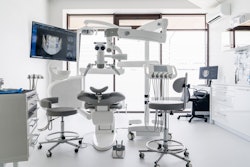The artificial intelligence (AI) boom has officially hit dentistry. Behind every faster claim submission, streamlined schedule, and smarter diagnostic insight, there’s AI quietly helping to do the work. While its presence is undeniable, its impact is still up for debate, especially for practice leaders who’ve seen more promised capabilities than real return on investment (ROI) at this stage in AI deployment.
For dental service organizations (DSOs) and independent practices alike, the question is no longer “Is AI coming?” but rather “What’s real, and what’s just hype?” Many tools sound promising but fall short of delivering measurable outcomes.
 Mike Huffaker.
Mike Huffaker.
That’s why it’s essential to evaluate AI based on what it’s actually doing for practices today. And the good news is that some tools are already making a tangible impact.
Here are three practical ways AI is helping dental practices right now with real improvements to operations, workflows, and patient experience.
Revenue cycle management
Ask any leader where they want to see AI make an impact, and revenue cycle management (RCM) is likely at the top of the list. It’s not hard to see why.
Few areas impact a dental practice’s efficiency and profitability more than RCM, yet it remains one of the hardest workflows to optimize. Manual claims submissions, payment posting, eligibility verification, and follow-up on denials take up valuable time and leave room for costly errors.
The good news is that AI can already ease this burden. Automation tools powered by machine learning can now verify patient eligibility in real time, validate claims before submission, flag errors that would trigger rejections, and even autopost payments once reimbursements are received. These advances are reducing days in accounts receivable and improving cash flow, which are outcomes any dental practice can appreciate.
With 18% of U.S. dental professionals integrating AI into their workflows and another 66% actively considering adoption, AI is becoming an essential part of modern dental practices, reshaping clinical decisions and enhancing operations.
These gains become even more pronounced as practices scale. While a single-location office may only save a few hours per week, multilocation DSOs can repurpose full-time employees toward higher-value activities.
That scale effect is where the real ROI of AI emerges, but practices must be discerning. If the tool doesn’t integrate seamlessly with your practice management platform, you won’t realize those efficiencies. Poorly connected systems can introduce new bottlenecks, or, worse, create billing errors that harm patient trust. In this category more than any other, integration isn’t optional, but foundational.
Front-office efficiency and patient communication
While back-office automation gets a lot of attention, front-office staff are also feeling the benefits of AI, particularly in how they communicate with patients. Think about the tasks your team performs every day: scheduling and rescheduling appointments, confirming visits, sending reminders, answering questions about insurance coverage or payment options, or providing pretreatment instructions.
Now imagine nearly half of those interactions being handled automatically and accurately by AI-powered virtual assistants or chatbots. These tools are already helping practices deliver 24/7 responsiveness without overextending staff while freeing up the team to focus on in-person experiences that build patient loyalty.
But just as quickly as these solutions can help, they can also frustrate if they’re not properly deployed. We've all had the experience of yelling “Human representative!” into a phone. AI-powered communication tools must be implemented with the same patient-centered mindset as clinical care. If they create friction or if they routinely escalate back to human agents, they offer less value than advertised.
Still, when thoughtfully integrated, AI can significantly reduce administrative overload. For example, practices using automated appointment confirmation tools see fewer no-shows and better schedule utilization. Some tools even flag at-risk cancellations based on historical behavior and help staff proactively fill the gap. This level of predictive support is where AI can truly shift a practice’s operations from reactive to proactive.
The key here is balance. AI should be seen as an extension of the team, not a replacement for it. Practices that use AI to offload the mundane rather than eliminate human connection are the ones seeing the strongest results.
Better diagnostic insights
One of the clearest examples of AI in action today is in radiographic imaging. Tools that analyze x-rays and flag potential issues like cavities, decay, or bone loss are now commonly integrated into imaging platforms. These tools aren’t replacing dentists, but they are helping support diagnostic consistency and confidence across providers.
Across large DSOs, this kind of decision support plays an important role. Providers can review suggested findings directly on the radiograph, use AI overlays to communicate treatment needs with patients, and deliver care with greater clarity and transparency. When AI provides consistent visual cues and comparative baselines, it helps clinicians focus on what matters most: the patient conversation.
But here too integration is vital. If your core practice management or imaging system doesn’t “speak the same language” as your AI tools, you’ll spend more time fixing mismatches than delivering care. That’s why forward-thinking practices are gravitating toward open, API-friendly platforms that make AI adoption smoother and more sustainable.
From demos to decisions: Making AI work for you
As AI solutions multiply, many dental practices will invest based on outcomes, not optics. Not every new feature deserves funding. Not every tool justifies the complexity of onboarding. But for those solutions that do deliver measurable, repeatable outcomes, the upside is considerable.
AI isn’t just about automation, it’s about enabling your team to work smarter, not harder. It’s about removing friction, supporting clinical excellence, and giving patients a more seamless experience. And most importantly, it’s about knowing what you’re trying to solve before you buy the solution.
As new AI vendors enter the space and consolidation reshapes the market, dental practices that adopt with intention and not impulse will be best positioned to lead. The future of AI in dentistry isn’t hype. It’s happening. You just need to know where to look.
Mike Huffaker is the chief revenue officer for Planet DDS. He spearheads both the sales and marketing divisions of the dental software solutions company. During his tenure, the company has achieved significant milestones, now proudly serving over 13,000 dental practices, including many large DSOs and emerging groups.
The comments and observations expressed herein do not necessarily reflect the opinions of DrBicuspid.com, nor should they be construed as an endorsement or admonishment of any particular idea, vendor, or organization.



















